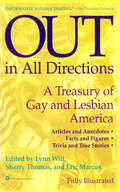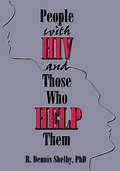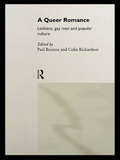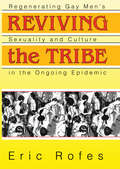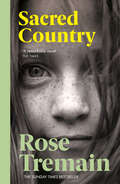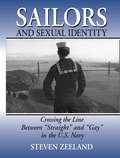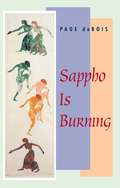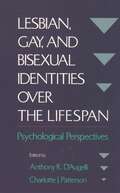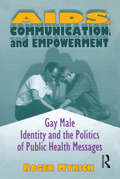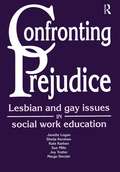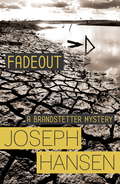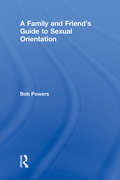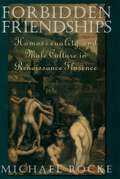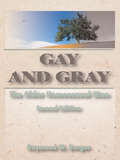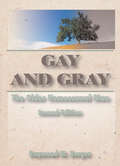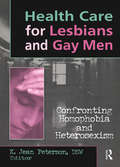- Table View
- List View
Out in All Directions: A Treasury of Gay and Lesbian America
by Eric Marcus Lynn Witt Sherry Thomas"FASCINATING...PROVOCATIVE AND FUNNY." - Contax Guide There has never been a better time to show the world - both gay and nongay - the depth and breadth of the people, the history, and the communities that have been created by gay men and lesbians. Out in All Directions presents a broad picture of the myriad cultures and achievements of gay people in society at large. Every chapter uncovers history, illuminates gay and lesbian life, explodes myths, and breaks new ground. The margins of text contain hundreds of sidebars: quotes, little known facts ("Did you know..."), and other outrageous comments ("Can you believe it?"). Cartoons, photographs, and other graphics are also included to illustrate and inform the the accompanying essays and articles. Out in All Directions is an entertaining, informative, and exciting exploration of the many rich facets of all that we call gay and lesbian.
People With HIV and Those Who Help Them: Challenges, Integration, Intervention
by Carlton Munson R Dennis ShelbyIn this guidebook, People With HIV and Those Who Help Them, author Dennis Shelby uses the reported experiences of HIV-positive men to chart the course of living with HIV. He offers a consistent clinical-theoretical framework that encompasses the vast range of clinical problems clinicians may encounter in their work with HIV-positive individuals across the span of infection.This book provides a detailed account of the many psychological transformations that infected people experience. People With HIV and Those Who Help Them enables clinicians and students to better address the problems commonly encountered in clinical practice with persons with HIV. Clinicians will be able to gain perspective on the process of knowing one is infected, infected men will see their process mirrored and validated, and family, friends, and partners of infected men will gain a greater appreciation for the experience of their relative, friend, and partner. As clinicians have gained experience in working with HIV-positive people, they have become increasingly aware of the complexity of successful clinical intervention with HIV-related problems. In his book, Shelby “breaks down” this complex process into its component aspects: psychological impact of HIV infection the process of adapting to the knowledge of infection the dynamic process involved with HIV infection common problems and solutions encountered by infected people case examples that illustrate the clinical framework intensive psychotherapy and HIV infectionThe study that is the basis for this book charts the initial psychological impact and many changes and transformations of the experience of being HIV-positive. While infected people are often encouraged to maintain hopeful outlooks and to think of themselves as living with HIV rather than dying from it, it is often a long and arduous process to achieve and maintain this perspective. People With HIV and Those Who Help Them is a guide to help those with HIV to keep a positive outlook on life.
People With HIV and Those Who Help Them: Challenges, Integration, Intervention
by Carlton Munson R Dennis ShelbyIn this guidebook, People With HIV and Those Who Help Them, author Dennis Shelby uses the reported experiences of HIV-positive men to chart the course of living with HIV. He offers a consistent clinical-theoretical framework that encompasses the vast range of clinical problems clinicians may encounter in their work with HIV-positive individuals across the span of infection.This book provides a detailed account of the many psychological transformations that infected people experience. People With HIV and Those Who Help Them enables clinicians and students to better address the problems commonly encountered in clinical practice with persons with HIV. Clinicians will be able to gain perspective on the process of knowing one is infected, infected men will see their process mirrored and validated, and family, friends, and partners of infected men will gain a greater appreciation for the experience of their relative, friend, and partner. As clinicians have gained experience in working with HIV-positive people, they have become increasingly aware of the complexity of successful clinical intervention with HIV-related problems. In his book, Shelby “breaks down” this complex process into its component aspects: psychological impact of HIV infection the process of adapting to the knowledge of infection the dynamic process involved with HIV infection common problems and solutions encountered by infected people case examples that illustrate the clinical framework intensive psychotherapy and HIV infectionThe study that is the basis for this book charts the initial psychological impact and many changes and transformations of the experience of being HIV-positive. While infected people are often encouraged to maintain hopeful outlooks and to think of themselves as living with HIV rather than dying from it, it is often a long and arduous process to achieve and maintain this perspective. People With HIV and Those Who Help Them is a guide to help those with HIV to keep a positive outlook on life.
A Queer Romance: Lesbians, Gay Men and Popular Culture
by Paul Burston Paul Burston Nfa Colin RichardsonIt's here and it's queer - popular culture inhabits all our lives, whether it comes in the form of movies or magazines, TV or shopping. A Queer Romance brings together critics, writers and artists to debate the possibilites of popular culture for lesbians and gay men. In a collection that is in-yer-face but never out-to-lunch, the contributors variously revisit debates about the gaze to provide a new theory of Queer viewing; discuss texts coded as queer - from lesbian vampires to Hollywood's use of gay codes in mainstream films such as Top Gun and Black Widow; consider the sexual and cultural narratives at play in the world of home shopping catalogues; explore the pleasures and perils of gay cultural production, from the radically queer film-making of Monika Treut to the wild world of homocore fanzines, and address the possibilities of texts claiming to be for the gay spectator - from pornography `by women, for women and about women' to `Out' TV. The contributors to A Queer Romance don't all agree but, taken together, the collection argues strongly that everyone can have their queer moments.
A Queer Romance: Lesbians, Gay Men and Popular Culture
by Paul Burston Colin RichardsonIt's here and it's queer - popular culture inhabits all our lives, whether it comes in the form of movies or magazines, TV or shopping. A Queer Romance brings together critics, writers and artists to debate the possibilites of popular culture for lesbians and gay men. In a collection that is in-yer-face but never out-to-lunch, the contributors variously revisit debates about the gaze to provide a new theory of Queer viewing; discuss texts coded as queer - from lesbian vampires to Hollywood's use of gay codes in mainstream films such as Top Gun and Black Widow; consider the sexual and cultural narratives at play in the world of home shopping catalogues; explore the pleasures and perils of gay cultural production, from the radically queer film-making of Monika Treut to the wild world of homocore fanzines, and address the possibilities of texts claiming to be for the gay spectator - from pornography `by women, for women and about women' to `Out' TV. The contributors to A Queer Romance don't all agree but, taken together, the collection argues strongly that everyone can have their queer moments.
Reviving the Tribe: Regenerating Gay Men's Sexuality and Culture in the Ongoing Epidemic
by Eric RofesReviving the Tribe creates a rich and brutally honest portrait of contemporary gay men’s lives amidst the seemingly endless AIDS epidemic and offers both autobiographical self-examination and a relentless critique of current sexual politics within the gay community. Fearlessly confronting the horrors experiences by surviving gay men without giving way to hopelessness, denial, or blame, Reviving the Tribe offers an inspiring blueprint for the gay community which faces a continuing spiral of disaster.In Reviving the Tribe, Author Eric Rofes argues that a return to the interrupted agenda of gay liberation may provide long-term motivation to keep gay men alive and spur rejuvenation of new generations of gay culture. By interweaving social history, psychology, anthropology, epidemiology, sociology, feminist theory, and sexology with his own journey through the epidemic, Rofes provides a moving and compelling argument for stepping out of the “state of emergency” and embracing a life beyond disease. He boldly offers a plan for community regeneration focused on restoring mental health, reclaiming sexuality, and mending the social fabric of communal gay life. Rofes asks unspoken questions lurking in gay men&’s minds and suggests answers to these questions, hitting such controversial topics as: gay men&’s sex cultures of the 1970s why “educated” gay men continue to become HIV-infected changing forms of gay masculinity the opening of new sex clubs and bathhouses leaving “rage activism” behind links between the Holocaust and AIDS unacknowledged roots in the feminist movement of gay men’s AIDS response mass denial of chronic trauma among gay menThe refusal to confront the ever-intensifying manifestations of AIDS has seriously endangered the foundation of contemporary gay communities. Rofes argues that many gay men suffer from the ”disaster syndrome,” a psychologically determined response that defends individuals against being overwhelmed by traumatic experience. In Reviving the Tribe, he provides a radical critique of contemporary gay political culture and suggests alternatives which offer the opportunity to face history, grapple with decimation, and regenerate communal life.Cautioning that an honest analysis of recent gay history and urban cultures promises neither to stop gay men’s suffering nor to end continuing HIV infections, Reviving the Tribe provides gay men with a clear lens through which they might scrutinize their lives, come to a new understanding of the epidemic’s impact on their generation, and redirect activism. This courageous and inspiring work brings Rofes’commanding intellect and twenty years of grassroots gay activism to bear on the challenging task of reconstructing gay life in the new mellennium. Reviving the Tribe is filled with insight of special interest to gay men, lesbians involved in the mixed lesbian/gay movement, sociologists, public health workers, psychologists, counselors, sex educators, religious leaders, and AIDS prevention policymakers searching for fresh vision.
Reviving the Tribe: Regenerating Gay Men's Sexuality and Culture in the Ongoing Epidemic
by Eric RofesReviving the Tribe creates a rich and brutally honest portrait of contemporary gay men’s lives amidst the seemingly endless AIDS epidemic and offers both autobiographical self-examination and a relentless critique of current sexual politics within the gay community. Fearlessly confronting the horrors experiences by surviving gay men without giving way to hopelessness, denial, or blame, Reviving the Tribe offers an inspiring blueprint for the gay community which faces a continuing spiral of disaster.In Reviving the Tribe, Author Eric Rofes argues that a return to the interrupted agenda of gay liberation may provide long-term motivation to keep gay men alive and spur rejuvenation of new generations of gay culture. By interweaving social history, psychology, anthropology, epidemiology, sociology, feminist theory, and sexology with his own journey through the epidemic, Rofes provides a moving and compelling argument for stepping out of the “state of emergency” and embracing a life beyond disease. He boldly offers a plan for community regeneration focused on restoring mental health, reclaiming sexuality, and mending the social fabric of communal gay life. Rofes asks unspoken questions lurking in gay men&’s minds and suggests answers to these questions, hitting such controversial topics as: gay men&’s sex cultures of the 1970s why “educated” gay men continue to become HIV-infected changing forms of gay masculinity the opening of new sex clubs and bathhouses leaving “rage activism” behind links between the Holocaust and AIDS unacknowledged roots in the feminist movement of gay men’s AIDS response mass denial of chronic trauma among gay menThe refusal to confront the ever-intensifying manifestations of AIDS has seriously endangered the foundation of contemporary gay communities. Rofes argues that many gay men suffer from the ”disaster syndrome,” a psychologically determined response that defends individuals against being overwhelmed by traumatic experience. In Reviving the Tribe, he provides a radical critique of contemporary gay political culture and suggests alternatives which offer the opportunity to face history, grapple with decimation, and regenerate communal life.Cautioning that an honest analysis of recent gay history and urban cultures promises neither to stop gay men’s suffering nor to end continuing HIV infections, Reviving the Tribe provides gay men with a clear lens through which they might scrutinize their lives, come to a new understanding of the epidemic’s impact on their generation, and redirect activism. This courageous and inspiring work brings Rofes’commanding intellect and twenty years of grassroots gay activism to bear on the challenging task of reconstructing gay life in the new mellennium. Reviving the Tribe is filled with insight of special interest to gay men, lesbians involved in the mixed lesbian/gay movement, sociologists, public health workers, psychologists, counselors, sex educators, religious leaders, and AIDS prevention policymakers searching for fresh vision.
Sacred Country
by Rose TremainWith an Introduction by Peter TatchellWe're all something else inside…1952. Standing in a cold Suffolk field with her family, six-year-old Mary Ward has a revelation: I am not Mary. That is a mistake. I am not a girl. I'm a boy.So begins Mary’s heroic struggle to change gender. Moving from the claustrophobic rural community of the 1950s to London in the swinging Sixties and beyond to the glitter of America in the Seventies, Sacred Country is the story of a journey to find a place of safety and fulfilment in a savage and confusing world.Over a million Rose Tremain books sold‘A writer of exceptional talent ... Tremain is a writer who understands every emotion’ Independent I‘There are few writers out there with the dexterity or emotional intelligence to rival that of the great Rose Tremain’ Irish Times‘Tremain has the painterly genius of an Old Master, and she uses it to stunning effect’ The Times‘Rose Tremain is one of the very finest British novelists’ Salman Rushdie‘Tremain is a writer of exemplary vision and particularity. The fictional world is rendered with extraordinary vividness’ Marcel Theroux, Guardian
Sailors and Sexual Identity: Crossing the Line Between "Straight" and "Gay" in the U.S. Navy
by Steven ZeelandIn Sailors and Sexual Identity, author Steven Zeeland talks with young male sailors--both gay- and straight-identified--about ways in which their social and sexual lives have been shaped by their Navy careers.Despite massive media attention to the issue, there remains a gross disparity between the public perception of “gays in the military” and the sexual realities of military life. The conversations in this book reveal how known “gay” and “straight” men can and do get along in the sexually tense confines of barracks and shipboard life once they discover that the imagined boundary between them is not, in fact, a hard line.The stories recounted here in vivid detail call into question the imagined boundaries between gay and straight, homosexual and homosocial, and suggest a secret Pentagon motivation for the gay ban: to protect homoerotic military rituals, buddy love, and covert military homosexuality from the taint of sexual suspicion.Zeeland’s interviews explore many aspects of contemporary life in the Navy including: gay/straight friendship networks the sexual charge to the Navy/Marine Corps rivalry the reality behind sailors’reputations as sexual adventurers in port and at sea men’s differing interpretations of homoerotic military rituals and initiations sex and gender stereotypes associated with military job specialities how sailors view being seen as sex objectsEveryone interested in the issue of gays in the military, along with a general gay readership, gay veterans, and gay men for whom sailors represent a sexual ideal, will find Sailors and Sexual Identity an informative and entertaining read.Visit Steven Zeeland at his home page: http://www.stevenzeeland.com
Sailors and Sexual Identity: Crossing the Line Between "Straight" and "Gay" in the U.S. Navy
by Steven ZeelandIn Sailors and Sexual Identity, author Steven Zeeland talks with young male sailors--both gay- and straight-identified--about ways in which their social and sexual lives have been shaped by their Navy careers.Despite massive media attention to the issue, there remains a gross disparity between the public perception of “gays in the military” and the sexual realities of military life. The conversations in this book reveal how known “gay” and “straight” men can and do get along in the sexually tense confines of barracks and shipboard life once they discover that the imagined boundary between them is not, in fact, a hard line.The stories recounted here in vivid detail call into question the imagined boundaries between gay and straight, homosexual and homosocial, and suggest a secret Pentagon motivation for the gay ban: to protect homoerotic military rituals, buddy love, and covert military homosexuality from the taint of sexual suspicion.Zeeland’s interviews explore many aspects of contemporary life in the Navy including: gay/straight friendship networks the sexual charge to the Navy/Marine Corps rivalry the reality behind sailors’reputations as sexual adventurers in port and at sea men’s differing interpretations of homoerotic military rituals and initiations sex and gender stereotypes associated with military job specialities how sailors view being seen as sex objectsEveryone interested in the issue of gays in the military, along with a general gay readership, gay veterans, and gay men for whom sailors represent a sexual ideal, will find Sailors and Sexual Identity an informative and entertaining read.Visit Steven Zeeland at his home page: http://www.stevenzeeland.com
Sappho Is Burning
by Page duBoisTo know all we know about Sappho is to know little. Her poetry, dating from the seventh century B.C.E., comes to us in fragments, her biography as speculation. How is it then, Page duBois asks, that this poet has come to signify so much? Sappho Is Burning offers a new reading of this archaic lesbian poet that acknowledges the poet's distance and difference from us and stresses Sappho's inassimilability into our narratives about the Greeks, literary history, philosophy, the history of sexuality, the psychoanalytic subject. In Sappho is Burning, duBois reads Sappho as a disruptive figure at the very origin of our story of Western civilization. Sappho is beyond contemporary categories, inhabiting a space outside of reductively linear accounts of our common history. She is a woman, but also an aristocrat, a Greek, but one turned toward Asia, a poet who writes as a philosopher before philosophy, a writer who speaks of sexuality that can be identified neither with Michel Foucault's account of Greek sexuality, nor with many versions of contemporary lesbian sexuality. She is named as the tenth muse, yet the nine books of her poetry survive only in fragments. She disorients, troubles, undoes many certitudes in the history of poetry, the history of philosophy, the history of sexuality. DuBois argues that we need to read Sappho again.
Lesbian, Gay, and Bisexual Identities over the Lifespan: Psychological Perspectives
Over the last fifteen years, psychological research regarding sexual orientation has seen explosive growth. In this book, Anthony R. D'Augelli and Charlotte J. Patterson bring together top experts to offer a comprehensive overview of what we have discovered--and what we still need to learn--about lesbian, gay, and bisexual identities. Writing in clear, nontechnical language, the contributors cover a range of topics, including conceptions of sexual identity, development over the lifespan, family and other personal relationships, parenting, and bigotry and discrimination. Lesbian, Gay, and Bisexual Identities Over the Lifespan is essential reading for researchers, students, social scientists, mental health practitioners, and general readers who seek the most up-to-date and authoritative treatment of the subject available.
AIDS, Communication, and Empowerment: Gay Male Identity and the Politics of Public Health Messages
by Roger MyrickAIDS, Communication, and Empowerment examines the cultural construction of gay men in light of discourse used in the media’s messages about HIV/AIDS--messages often represented as educational, scientific, and informational but which are, in fact, politically charged. The book offers a compelling and substantive look at the social consequences of communication about HIV/AIDS and the reasons for the successes and failures of contemporary health communication. This analysis is important because it provides a reading of health communication from a marginal perspective, one that has often been kept silent in mainstream academic research. AIDS, Communication, and Empowerment offers a critical, historical analysis of public health communication about HIV/AIDS; the ways this communication makes sense historically and culturally; and the implications such messages have for the marginal group which has been most stigmatized as a consequence of these messages. It covers such topics as: the relationship among gay identity, language, and power cultural studies of the historical development of gay identity studies in health communication about HIV/AIDS and health risk communication the political consequences of public health education about HIV/AIDS on gay men the political consequences of media representations of gay identity and its relationship to disease Based primarily on the French scholar Michel Foucault’s critical, historical analysis of discourse and sexuality, this book takes a timely and original approach which differs from traditional, quantitative communication studies. It examines the relationship between language and culture using a qualitative, cultural studies approach which places medicalization theories in the broader context of histories of sexuality, the discursive development of contemporary gay identity, and recent public health communication.Author Roger Myrick explains how mainstream communication about HIV/AIDS relentlessly stigmatizes and further marginalizes gay identity. He describes how national health education stigmatizes groups by associating them with images of disease and “otherness.” Even communication which originates from marginal groups, particularly those relying on federal funds, often participates in linking gay identities with disease. According to Myrick, government funding, while often necessary for the continuation of community-based health campaigns, poses obvious and direct restrictions on effective marginal education. AIDS, Communication, and Empowerment allows for a rethinking of ways marginal groups can take control of their own education on public health issues. As HIV/AIDS cases continue to rise dramatically among marginalized and disenfranchised groups, analysis of health communication directed toward them becomes crucial to their survival. This book provides valuable insights and information for scholars, professionals, readers interested in the relationship among language, power and marginal identity, and for classes in gay and lesbian studies, health communication, or political communication.
AIDS, Communication, and Empowerment: Gay Male Identity and the Politics of Public Health Messages
by Roger MyrickAIDS, Communication, and Empowerment examines the cultural construction of gay men in light of discourse used in the media’s messages about HIV/AIDS--messages often represented as educational, scientific, and informational but which are, in fact, politically charged. The book offers a compelling and substantive look at the social consequences of communication about HIV/AIDS and the reasons for the successes and failures of contemporary health communication. This analysis is important because it provides a reading of health communication from a marginal perspective, one that has often been kept silent in mainstream academic research. AIDS, Communication, and Empowerment offers a critical, historical analysis of public health communication about HIV/AIDS; the ways this communication makes sense historically and culturally; and the implications such messages have for the marginal group which has been most stigmatized as a consequence of these messages. It covers such topics as: the relationship among gay identity, language, and power cultural studies of the historical development of gay identity studies in health communication about HIV/AIDS and health risk communication the political consequences of public health education about HIV/AIDS on gay men the political consequences of media representations of gay identity and its relationship to disease Based primarily on the French scholar Michel Foucault’s critical, historical analysis of discourse and sexuality, this book takes a timely and original approach which differs from traditional, quantitative communication studies. It examines the relationship between language and culture using a qualitative, cultural studies approach which places medicalization theories in the broader context of histories of sexuality, the discursive development of contemporary gay identity, and recent public health communication.Author Roger Myrick explains how mainstream communication about HIV/AIDS relentlessly stigmatizes and further marginalizes gay identity. He describes how national health education stigmatizes groups by associating them with images of disease and “otherness.” Even communication which originates from marginal groups, particularly those relying on federal funds, often participates in linking gay identities with disease. According to Myrick, government funding, while often necessary for the continuation of community-based health campaigns, poses obvious and direct restrictions on effective marginal education. AIDS, Communication, and Empowerment allows for a rethinking of ways marginal groups can take control of their own education on public health issues. As HIV/AIDS cases continue to rise dramatically among marginalized and disenfranchised groups, analysis of health communication directed toward them becomes crucial to their survival. This book provides valuable insights and information for scholars, professionals, readers interested in the relationship among language, power and marginal identity, and for classes in gay and lesbian studies, health communication, or political communication.
Confronting Prejudice: Lesbian and Gay Issues in Social Work Education
by Janette Logan Sheila Kershaw Kate Karban Sue Mills Joy Trotter Margo SinclairThis book brings lesbian and gay issues to the centre of the debate on anti-oppressive practice. It is an accessible and practical guide to the subject for all involved in student learning, aiming to provide practice teachers and educators with tools to help students develop their understanding of the effects of heterosexism as well as providing strategies for positive practice. Part 1 considers: ¢ the social background, raising important issues about the ways in which lesbians and gay men are marginalised in society and the subsequent reflection in social work education and practice; ¢ the legal framework within which social workers and probation officers operate, drawing attention to some of the tensions and dilemmas facing practitioners attempting to develop anti-discriminatory and anti-oppressive practice; ¢ a framework within which to develop non-homophobic and non-heterosexist practice within the Diploma in Social Work, raising important issues which need to be addressed both within the academic institutions and the practice learning environment; ¢ how to facilitate students’ learning in relation to anti-discriminatory and anti-oppressive practice with lesbian and gay service users; ¢ the assessment of students’ competence within the academic and practice curriculum; ¢ a model of good practice in working with lesbians and gay men, offering practical suggestions which can be incorporated into existing policies and procedures. Part 2 provides practical teaching and training materials including how to organise the training session, exercises and notes for trainers. these can be adapted to reflect individual or group needs, within the practice learning or academic environment.
Confronting Prejudice: Lesbian and Gay Issues in Social Work Education
by Janette Logan Sheila Kershaw Kate Karban Sue Mills Joy Trotter Margo SinclairThis book brings lesbian and gay issues to the centre of the debate on anti-oppressive practice. It is an accessible and practical guide to the subject for all involved in student learning, aiming to provide practice teachers and educators with tools to help students develop their understanding of the effects of heterosexism as well as providing strategies for positive practice. Part 1 considers: ¢ the social background, raising important issues about the ways in which lesbians and gay men are marginalised in society and the subsequent reflection in social work education and practice; ¢ the legal framework within which social workers and probation officers operate, drawing attention to some of the tensions and dilemmas facing practitioners attempting to develop anti-discriminatory and anti-oppressive practice; ¢ a framework within which to develop non-homophobic and non-heterosexist practice within the Diploma in Social Work, raising important issues which need to be addressed both within the academic institutions and the practice learning environment; ¢ how to facilitate students’ learning in relation to anti-discriminatory and anti-oppressive practice with lesbian and gay service users; ¢ the assessment of students’ competence within the academic and practice curriculum; ¢ a model of good practice in working with lesbians and gay men, offering practical suggestions which can be incorporated into existing policies and procedures. Part 2 provides practical teaching and training materials including how to organise the training session, exercises and notes for trainers. these can be adapted to reflect individual or group needs, within the practice learning or academic environment.
Emma in Love: Jane Austen's Emma Continued
by Emma TennantTwo years after Emma Woodhouse married Mr Knightley and they have settled into loving, if not quite passionate, matrimony; Emma is bored.To amuse herself, Emma decides to take up matchmaking again, whether her husband will have it or not. But this time Emma is playing for dangerously high stakes. Recently widowed John Knightley, her brother-in-law, is in need of a wife, so when a fascinating French woman enters Highbury society, Emma sees a golden opportunity. Eliza d'Arblay is of French aristocrat whose parents fled the French Revolution. Beautiful, intriguing and romantic, Emma deems her to be the perfect match for John. But as Eliza charms Highbury society, John isn't the only one who falls deeply in love with her...a passion awakes in Emma that she never would have expected.
Fadeout: Dave Brandstetter Investigation 1 (Dave Brandstetter)
by Joseph HansenAfter forty years, Hammett has a worthy successor' The TimesDave Brandstetter stands alongside Philip Marlowe, Sam Spade and Lew Archer as one of the best fictional PIs in the business. Like them, he was tough, determined, and ruthless when the case demanded it. Unlike them, he was gay. Joseph Hansen's groundbreaking novels follow Brandstetter as he investigates cases in which motives are murky, passions run high, and nothing is ever as simple as it looks. Set in 1970s and 80s California, the series is a fascinating portrait of a time and a place, with mysteries to match Chandler and Macdonald.In Fadeout, Dave is sent to investigate the death of radio personality Fox Olsen. His car is found crashed in a dry river bed. But there is no body - and as Dave looks deeper into his life, it seems as though he had good reasons to disappear.
A Family and Friend's Guide to Sexual Orientation: Bridging the Divide Between Gay and Straight
by Bob Powers Alan EllisA Family and Friend's Guide to Sexual Orientation helps individuals and families to bridge the divide between gay and straight, to heal wounds that often accompany individuals and families' negative feelings about lesbians, gay men, bisexuals, and transgendered persons. Consisting of thirty stories by individuals who have come to accept and embrace their own sexuality, twelve of the stories are by heterosexuals who, in addition to talking about their own sexuality, speak of the homosexuality of a loved one. The book also includes five personal stories from two families.
A Family and Friend's Guide to Sexual Orientation: Bridging the Divide Between Gay and Straight
by Bob Powers Alan EllisA Family and Friend's Guide to Sexual Orientation helps individuals and families to bridge the divide between gay and straight, to heal wounds that often accompany individuals and families' negative feelings about lesbians, gay men, bisexuals, and transgendered persons. Consisting of thirty stories by individuals who have come to accept and embrace their own sexuality, twelve of the stories are by heterosexuals who, in addition to talking about their own sexuality, speak of the homosexuality of a loved one. The book also includes five personal stories from two families.
Forbidden Friendships: Homosexuality and Male Culture in Renaissance Florence (Studies in the History of Sexuality)
by Michael Rocke"This is a superb work of scholarship, impossible to overpraise.... It marks a milestone in the 20-year rise of gay and lesbian studies."--Martin Duberman, The Advocate The men of Renaissance Florence were so renowned for sodomy that "Florenzer" in German meant "sodomite." In the late fifteenth century, as many as one in two Florentine men had come to the attention of the authorities for sodomy by the time they were thirty. In 1432 The Office of the Night was created specifically to police sodomy in Florence. Indeed, nearly all Florentine males probably had some kind of same-sex experience as a part of their "normal" sexual life. Seventy years of denunciations, interrogations, and sentencings left an extraordinarily detailed record, which author Michael Rocke has used in his vivid depiction of this vibrant sexual culture in a world where these same-sex acts were not the deviant transgressions of a small minority, but an integral part of a normal masculine identity. Rocke roots this sexual activity in the broader context of Renaissance Florence, with its social networks of families, juvenile gangs, neighbors, patronage, workshops, and confraternities, and its busy political life from the early years of the Republic through the period of Lorenzo de' Medici, Savonarola, and the beginning of Medici princely rule. His richly detailed book paints a fascinating picture of Renaissance Florence and calls into question our modern conceptions of gender and sexual identity.
Gay and Gray: The Older Homosexual Man, Second Edition
by Raymond BergerIn the absence of accurate information, American culture has upheld a distorted view of what it means to be an older gay man. Gay and Gray is the first and only scholarly full-length treatment of older gay men in America today. It breaks the stereotype that older gay men are strange, lonely creatures and reveals that most older gay men are well-adjusted to their homosexuality and the aging process.This second edition contains four new chapters that present additional perspectives on the reality of gay aging. Dr. Minnigerode&’s study shows that older gay men do not perceive themselves as growing old faster than their heterosexual counterparts, and that forty is the age at which most gay men believe that the label “young” no longer applies--this finding led Berger and other researchers to define “older” gay men as those over forty. Pope and Schulz confirm Berger&’s finding that for most older gay men a continuation of sexual activity and sexual enjoyment is the norm. John Grube&’s paper on the interaction of older gay men with younger gay liberationists explores the cultural divide between today&’s older gay man and his younger counterpart, filling a gap left in the first edition. And a concluding chapter by Richard Friend on a theory of successful gay aging summarizes much of the current thinking about this topic. The true situation of the older homosexual male presented in Gay and Gray challenges preconceptions about what it means to be old and gay. It asserts that in most ways, older gay men are indistinguishable from other older people. Because the book portrays older gay men in a realistic and sympathetic light, it is therapeutic for the many gay men who have been burdened with society&’s negative and distorted views about them. These men may compare their own lives to those of the respondents described in the book. Gay and Gray offers younger gay men a rare glimpse into their futures and enlightens and comforts those who count older gay men among their family and friends. The conclusions drawn in the book will change people&’s perspectives and offer new ways of thinking for and about older gay men.Gay and Gray is filled with rich case histories and treats its subject with dignity and compassion. Topics of focus include: love relationships social and psychological adjustment gay community self-acceptance being ”in the closet” and ”coming out” as a gay person intergenerational attitudes popular stereotypesAs the first intensive interview and questionnaire study of gay men aged 40 and older in America, Gay and Gray examines the lives of these men in light of cultural stereotypes. Author Berger asks about the social lives of these men, their involvement in both the heterosexual and homosexual communities, their ”coming out” experiences, their attitudes about younger gays, their experiences in growing older, and their strategies for adapting to life&’s challenges. In the study, Berger reveals that, contrary to stereotypic views, most older gay men are well-integrated into social networks and lead active and generally satisfying lives. He found that few live alone; most scored as well as younger gays on measures of psychological adjustment, such as self-acceptance; many are open about their homosexuality with family, friends, and colleagues; and the most well-adjusted older gay men were integrated into a homosexual community, associated with younger gay men, and were unwilling to change their sexual orientation.
Gay and Gray: The Older Homosexual Man, Second Edition
by Raymond BergerIn the absence of accurate information, American culture has upheld a distorted view of what it means to be an older gay man. Gay and Gray is the first and only scholarly full-length treatment of older gay men in America today. It breaks the stereotype that older gay men are strange, lonely creatures and reveals that most older gay men are well-adjusted to their homosexuality and the aging process.This second edition contains four new chapters that present additional perspectives on the reality of gay aging. Dr. Minnigerode&’s study shows that older gay men do not perceive themselves as growing old faster than their heterosexual counterparts, and that forty is the age at which most gay men believe that the label “young” no longer applies--this finding led Berger and other researchers to define “older” gay men as those over forty. Pope and Schulz confirm Berger&’s finding that for most older gay men a continuation of sexual activity and sexual enjoyment is the norm. John Grube&’s paper on the interaction of older gay men with younger gay liberationists explores the cultural divide between today&’s older gay man and his younger counterpart, filling a gap left in the first edition. And a concluding chapter by Richard Friend on a theory of successful gay aging summarizes much of the current thinking about this topic. The true situation of the older homosexual male presented in Gay and Gray challenges preconceptions about what it means to be old and gay. It asserts that in most ways, older gay men are indistinguishable from other older people. Because the book portrays older gay men in a realistic and sympathetic light, it is therapeutic for the many gay men who have been burdened with society&’s negative and distorted views about them. These men may compare their own lives to those of the respondents described in the book. Gay and Gray offers younger gay men a rare glimpse into their futures and enlightens and comforts those who count older gay men among their family and friends. The conclusions drawn in the book will change people&’s perspectives and offer new ways of thinking for and about older gay men.Gay and Gray is filled with rich case histories and treats its subject with dignity and compassion. Topics of focus include: love relationships social and psychological adjustment gay community self-acceptance being ”in the closet” and ”coming out” as a gay person intergenerational attitudes popular stereotypesAs the first intensive interview and questionnaire study of gay men aged 40 and older in America, Gay and Gray examines the lives of these men in light of cultural stereotypes. Author Berger asks about the social lives of these men, their involvement in both the heterosexual and homosexual communities, their ”coming out” experiences, their attitudes about younger gays, their experiences in growing older, and their strategies for adapting to life&’s challenges. In the study, Berger reveals that, contrary to stereotypic views, most older gay men are well-integrated into social networks and lead active and generally satisfying lives. He found that few live alone; most scored as well as younger gays on measures of psychological adjustment, such as self-acceptance; many are open about their homosexuality with family, friends, and colleagues; and the most well-adjusted older gay men were integrated into a homosexual community, associated with younger gay men, and were unwilling to change their sexual orientation.
Health Care for Lesbians and Gay Men: Confronting Homophobia and Heterosexism
by K Jean PetersonHealth Care for Lesbians and Gay Men educates practitioners about the special needs of gay and lesbian patients and how to look critically at the impact of homophobia and heterosexism on the provision of care. It provides an overview of critical health care issues for lesbians and gay men and offers concrete suggestions to health practitioners and social workers on how to address these issues in order to guarantee the best care for their patients and clients. Authors in Health Care for Lesbians and Gay Men give health care providers and mental health workers practical interventions; suggestions for advocacy, social change, grassroots efforts, and alternative programs; and lessons about how to use existing procedures to more effectively meet the unique health care needs of gays and lesbians. Practitioners also learn how to utilize legal action in securing and protecting patients’and clients’personal health care wishes. Chapters in this book cover: how homophobia and negative attitudes can directly compromise the care given to lesbians and gay men. heterosexism and biases which exclude the partners of gay men and lesbians from participating in the care of their loved ones. legal issues and the need for legal recognition of gay and lesbian relationships, both to enhance the provision of care and for financial access to health care presently available to only heterosexual, married couples. legal protection and special legal documents that ensure that the wishes of gay men and lesbians are honored and the integrity of their relationships not violated.Health Care for Lesbians and Gay Men starts with special issues confronting adolescents and the special role health care providers can play in supporting the struggles of lesbian and gay adolescents. It then continues to look at these issues over the life cycle. Three themes emerge as authors try to explain problems and possible solutions for lesbians and gay men seeking health care: the pervasive homophobia and heterosexism found throughout the health care system and the impact these attitudes and beliefs have on the health care of lesbians and gay men; the need for education in professional programs on special health issues of gay men and lesbians; and the critical role that social workers can play in both educating others about the special needs of their gay and lesbian clients and in advocating for their clients in various health care settings.Health Care for Lesbians and Gay Men is essential reading for social work and social service practitioners and students working in the health care field, advanced undergraduates and graduate students of social work, professionals and students of nursing and medicine, and others concerned with the quality and equality of health care services. It urges students and professionals to challenge and evaluate their own attitudes, beliefs, and behaviors in order to ensure quality services to all clients and patients.
Health Care for Lesbians and Gay Men: Confronting Homophobia and Heterosexism
by K Jean PetersonHealth Care for Lesbians and Gay Men educates practitioners about the special needs of gay and lesbian patients and how to look critically at the impact of homophobia and heterosexism on the provision of care. It provides an overview of critical health care issues for lesbians and gay men and offers concrete suggestions to health practitioners and social workers on how to address these issues in order to guarantee the best care for their patients and clients. Authors in Health Care for Lesbians and Gay Men give health care providers and mental health workers practical interventions; suggestions for advocacy, social change, grassroots efforts, and alternative programs; and lessons about how to use existing procedures to more effectively meet the unique health care needs of gays and lesbians. Practitioners also learn how to utilize legal action in securing and protecting patients’and clients’personal health care wishes. Chapters in this book cover: how homophobia and negative attitudes can directly compromise the care given to lesbians and gay men. heterosexism and biases which exclude the partners of gay men and lesbians from participating in the care of their loved ones. legal issues and the need for legal recognition of gay and lesbian relationships, both to enhance the provision of care and for financial access to health care presently available to only heterosexual, married couples. legal protection and special legal documents that ensure that the wishes of gay men and lesbians are honored and the integrity of their relationships not violated.Health Care for Lesbians and Gay Men starts with special issues confronting adolescents and the special role health care providers can play in supporting the struggles of lesbian and gay adolescents. It then continues to look at these issues over the life cycle. Three themes emerge as authors try to explain problems and possible solutions for lesbians and gay men seeking health care: the pervasive homophobia and heterosexism found throughout the health care system and the impact these attitudes and beliefs have on the health care of lesbians and gay men; the need for education in professional programs on special health issues of gay men and lesbians; and the critical role that social workers can play in both educating others about the special needs of their gay and lesbian clients and in advocating for their clients in various health care settings.Health Care for Lesbians and Gay Men is essential reading for social work and social service practitioners and students working in the health care field, advanced undergraduates and graduate students of social work, professionals and students of nursing and medicine, and others concerned with the quality and equality of health care services. It urges students and professionals to challenge and evaluate their own attitudes, beliefs, and behaviors in order to ensure quality services to all clients and patients.
